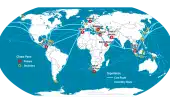Johannah Bernstein post: "eternally proud of my father’s extraordinary aeronautical engineering. legacy. here is a photo of the Canadair Water…
Baltimore Bridge collapse – Infrastructure
Written by Diana Thebaud Nicholson // September 18, 2024 // Economy, U.S. // Comments Off on Baltimore Bridge collapse – Infrastructure
The Bipartisan Infrastructure Deal
6 November 2021
4 January 2023
FACT SHEET: President Biden, Vice President Harris, Senior Administration Officials Kick Off 2023 Implementing Bipartisan Infrastructure Law
The Bipartisan Infrastructure Law invests $40 billion to repair and rebuild the nation’s bridges – the single largest dedicated investment in bridges since the construction of the Eisenhower-era Interstate Highway System. It will help repair or rebuild ten of the most economically significant bridges in the country along with over 15,000 additional bridges nationwide. The vast majority of the projects funded by the Bipartisan Infrastructure Law are covered by Davis-Bacon requirements, meaning the construction workers who build the projects will receive good pay and benefits.
30 March
Map: Where U.S. bridges are most in need of repair (see map)
(Axios) While the bridge collapse in Baltimore was due to a series of unlikely accidents rather than crumbling infrastructure, the incident has put renewed focus on the vulnerability of bridges across the U.S.
The big picture: The Department of Transportation considers 6.8% of the over 600,000 bridges it tracks and rates to be in “poor” condition. That doesn’t sound too bad on a percentage basis, but it’s over 40,000 bridges in total.
The trend nationwide is actually quite positive over the past two decades, according to the Department of Transportation data.
The percentage of bridges in poor condition has been halved from 15.2% in 2000 to 6.8% now.
18 September
Justice Department Files $100 Million Claim in Fatal Baltimore Bridge Collapse
(NYT) The crash of the Dali into the Francis Scott Key Bridge killed six people. The federal government says the owner and the operator were “grossly negligent” and “reckless.”
The U.S. Justice Department filed a legal claim on Wednesday against the owner and operator of the container ship that collapsed the Francis Scott Key Bridge last March, killing six workers and paralyzing the Port of Baltimore for weeks.
The lawsuit asserts that the companies’ actions leading up to the catastrophe were “outrageous, grossly negligent, willful, wanton, and reckless.”
The government is seeking more than $100 million in damages to cover the costs of the sprawling emergency response to the disaster and the federal aid to port employees who were put out of work.
29 August
Maryland awards contract for rebuilding of Francis Scott Key Bridge after deadly collapse
Maryland transportation leaders on Thursday approved a contract for rebuilding the Francis Scott Key Bridge several months after the 2.6-kilometre steel span collapsed under the impact of a massive container ship that lost power and crashed into one of its supporting columns.
In the immediate aftermath of the deadly March 26 collapse, officials quickly promised to rebuild the bridge – a long-standing Baltimore landmark and vital piece of transportation infrastructure.
They cited a 2028 completion date and estimated the project would cost US$1.7-billion and would include significantly more pier protection to better defend against future wayward ships.
At a monthly meeting Thursday morning, the Maryland Transportation Authority board awarded a US$73-million contract for the first phase of the project to Kiewit Infrastructure, which calls itself “one of North America’s largest and most respected engineering and construction organizations.”
15 June
Can Baltimore Get a Great Bridge?
Designers and engineers can create bridges that also serve as monumental artworks and civic landmarks. Why do new spans in the US so often fall short?
By James S. Russell
(Bloomberg) Before its destruction made it famous, the Key Bridge was not really a landmark like San Francisco’s Golden Gate Bridge or other charismatic spans that serve as symbols for their host cities. Built in 1977, it was a more utilitarian structure, with brawny trusswork that evoked the city’s industrial past, and an important job to do: It could carry the fuel-hauling tanker trucks that are prohibited from traveling through two nearby tunnels. Its visibility at the mouth of Baltimore’s harbor marked it as a prominent link between the modest communities that line the blue-collar waterfront and the glass apartment and office towers that now define the downtown skyline.
Before its destruction made it famous, the Key Bridge was not really a landmark like San Francisco’s Golden Gate Bridge or other charismatic spans that serve as symbols for their host cities. Built in 1977, it was a more utilitarian structure, with brawny trusswork that evoked the city’s industrial past, and an important job to do: It could carry the fuel-hauling tanker trucks that are prohibited from traveling through two nearby tunnels. Its visibility at the mouth of Baltimore’s harbor marked it as a prominent link between the modest communities that line the blue-collar waterfront and the glass apartment and office towers that now define the downtown skyline.
America once fielded world-class bridge designers and engineers and celebrated their work, from John Roebling’s Brooklyn Bridge of 1883 to Othmar Ammann’s Verrazzano-Narrows Bridge of 1964. In the interstate highway era, however, commitment to great bridge design faded as transportation departments put a premium on getting miles built rather than being responsive to communities. Over the years, builders seem to have lost the ability to affordably erect major infrastructure — particularly those with non-standard designs — and transportation officials have lost the ability to manage challenging projects.
15 April
Ship that caused bridge collapse had apparent electrical issues while still docked, AP source says
(AP) — Hours before leaving port, the massive container ship that caused the deadly collapse of a Baltimore bridge experienced apparent electrical problems, a person with knowledge of the situation told The Associated Press on Monday, the same day FBI agents boarded the vessel amid a criminal investigation into the circumstances leading up to the catastrophe.
Officials with the National Transportation Safety Board have said their investigation will include an inquiry into whether the ship experienced power issues before starting its voyage.
Board Chair Jennifer Homendy said last week the investigation is focused on the ship’s electrical system generally. The ship experienced power issues moments before the crash, as is evident in videos that show its lights going out and coming back on.
Homendy said information gleaned from the vessel’s voyage data recorder is relatively basic, “so that information in the engine room will help us tremendously.”
The FBI is now conducting a criminal investigation into the bridge collapse that is focused on the circumstances leading up to it and whether all federal laws were followed, according to a different person familiar with the matter. The person wasn’t authorized to discuss details of the investigation publicly and spoke to the AP on the condition of anonymity.
8 April
Salvage crews have begun removing containers from the ship that collapsed Baltimore’s Key bridge
(AP) — Salvage crews on Sunday began removing containers from the deck of the cargo ship that crashed into and collapsed the Francis Scott Key Bridge in Baltimore, an important step toward the full reopening of one of the nation’s main shipping lanes.
The removal of the containers from the deck of the Dali would continue this week as weather permits, according to a statement from the Key Bridge Response Unified Command. Crews were progressing toward removing sections of the bridge that lie across the ship’s bow to eventually allow it to move, the statement said.
In total, 32 vessels have passed through temporary channels on either side of the wreckage, officials said.
“The Unified Command is concurrently progressing on its main lines of effort to remove enough debris to open the channel to larger commercial traffic,” U.S. Coast Guard Capt. David O’Connell said in the statement.
4 April
Baltimore shipping set to resume by end of April with full capacity by end of May
By Daniel Trotta
(Reuters) – The U.S. Army Corps of Engineers said Thursday it expects to open a new channel to the Port of Baltimore by the end of April, freeing up commercial shipping blocked by a collapsed bridge, and then restore port access to full capacity by the end of May.
The Army Corps, part of a multiagency team responding to the Baltimore disaster, announced the plans one day ahead of a visit by President Joe Biden, saying that within four weeks the channel would be suitable for some roll-on/roll-off vessels that transport automobiles and farm equipment.
The Port of Baltimore ranks first in the United States for the volume it handles of autos and light trucks and farm and construction machinery, according to the state of Maryland. Most of that traffic has been suspended since the accident, though some terminal operations outside the affected area have resumed.
Earlier this week, two auxiliary channels suitable for emergency vessels, tugs and barges were opened on either side of the disabled ship, which is stuck beneath bridge debris with thousands of containers and a crew of 21 sailors still aboard.
But with depths limited to 11 feet (3.35 meters) and 14 feet, those two channels are too shallow for major cargo ships, which need a depth of 35 feet.
“USACE expects to open a limited access channel 280 feet wide and 35 feet deep, to the Port of Baltimore within the next four weeks – by the end of April,” the corps said.
1 April
Baltimore bridge: Alternative route to open for shipping
(BBC) A temporary alternative route for ships is to be opened in the US city of Baltimore following the collapse of a major bridge, officials have announced.
…efforts are under way to remove debris from the water.
A 200-tonne piece of the bridge was removed on Saturday.
Those involved in the clean-up have been cutting debris from the bridge into smaller pieces that can be removed and taken to a disposal site.
Biden visit to bridge collapse announced as channel opens to Baltimore port
President Biden will visit Baltimore on Friday to survey the Francis Scott Key Bridge collapse, the White House announced Monday, as authorities said they have opened a small channel that will allow limited shipping at the Port of Baltimore for the first time since the disaster.
Biden plans to meet with local and state officials and assess the nascent recovery effort on the Patapsco River, White House press secretary Karine Jean-Pierre said. She also said two offices were opened Monday in Baltimore to help small businesses affected by the disaster apply for low-interest federal relief loans of up to $2 million.
Rear Adm. Shannon N. Gilreath with the U.S. Coast Guard said at a news conference that a channel with a depth of 11 feet has been opened north of the collapsed bridge that will allow commercial barges and tugboats to travel in and out of the port, which has been closed to boat traffic since Tuesday.
31 March
Baltimore braces for economic hit amid fears port shuttered for months
Some fear business that shifts to other ports may go for good
(WaPo) Logistics and freight companies as well as retail businesses are bracing for a lengthy interruption in port operations that could exact a steep financial toll.
How a Panama Canal change brought big ships like the Dali to Baltimore
Maryland officials saw economic opportunity in the larger ships. Then one hit the Key Bridge.
The ship that struck Baltimore’s Francis Scott Key Bridge this week was one of a new, larger class that began plying the route from Asia to the East Coast via the Panama Canal in 2016, when locks in the canal were expanded to make room for the bigger vessels increasingly favored by shipping companies.
Officials in Maryland had seen the economic opportunity presented by the larger ships, which made the long trip up the Chesapeake Bay more worthwhile to ship owners. The port installed four new cranes capable of handling gargantuan container ships and had its harbor dredged to the 50-foot depth needed to fit them, putting it in a club of three East Coast ports then ready to welcome the world’s largest vessels.
30 March
The last hours of Baltimore’s Key Bridge: Dark. Quiet. Then chaos and tragedy.
The trouble began at 1:24 a.m. Tuesday as a cargo ship almost the size of the Eiffel Tower steered southeast on the Patapsco River out of Baltimore. Just ahead, spanning more than a mile across the darkened water, stood the Francis Scott Key Bridge, 185 feet high, with a crew of overnight construction workers on the road deck, patching cracks and filling potholes.
(WaPo) Hundreds of times a year, gargantuan vessels like this one, laden with containers of freight, had eased beneath the Key, bound for open ocean and ports around the globe. But as the Dali reached eight knots and drew closer to the bridge, what should have been a routine passage suddenly wasn’t.
First, the giant ship’s lights blinked out. About a minute later, electricity returned, then the lights went off again.
The ensuing catastrophe will long reverberate — in coming months of economic disruption, vast rebuilding costs and incessant commuting headaches — but most profoundly in the lasting anguish of families, in their grief for lost loved ones.
… Investigators are now exploring what happened, examining everything from possible “dirty fuel” that might have caused the power outage to questions about the bridge design and its ability to withstand such a blow.
Chartered by a Danish shipping giant, flagged in Singapore and operated by a Singaporean company, the Dali can carry nearly 10,000 containers — though it had only about 4,700 at the time — and more than 100,000 metric tons. Now all of it, the mammoth freighter and its staggering weight of cargo, was adrift and unstoppable as it bore down on the bridge, headed for one of the immense concrete support piers rising from the water and holding up the span.
29 March
The Dali ship crew is still on board after hitting the Baltimore bridge
(WaPo) Days after the Dali lost power and hit the Francis Scott Key Bridge on Tuesday, the crew remains on the massive cargo ship stuck in the middle of Baltimore’s harbor.
The two pilots are also still on the ship, a spokeswoman for the Key Bridge Joint Information Center said. That “unified command” is handling outreach for federal and state agencies involved in the disaster, as well as the company that manages the Dali.
At a news conference Friday, officials said moving the ship was a second priority, after reopening the shipping lane in and out of the Port of Baltimore. Ledoux said moving the ship would require a damage assessment once the bridge parts are removed, including divers checking for damage underwater, and then clearance from authorities to tug the boat.
Economic impact of the Baltimore bridge collapse (podcast)
(Brookings) … An important aspect that a lot of people don’t talk about is Baltimore is actually, among East Coast ports, it’s the closest geographically to the Midwest. So, so even if some of that traffic is diverted to other East Coast ports…it doesn’t change the fact that Baltimore still has a strategic location in terms of our freight networks to reaching some of those inland destinations too. So, just because the vessel and container traffic might be shifting on the coast, doesn’t change the fact that truck traffic in particular has to go in different routes to inland.
Heather Cox Richardson: March 28, 2024
In 2007, when a bridge across the Mississippi River in Minneapolis suddenly collapsed, Congress passed funding to rebuild it in days and then-president George W. Bush signed the measure into law within a week of the accident.
Yesterday the National Economic Council called a meeting of the Supply Chain Disruptions Task Force, which the Biden-Harris administration launched in 2021, to discuss the impact of the collapse of the Francis Scott Key Bridge and the partial closure of the Port of Baltimore on regional and national supply chains. The task force draws members from the White House and the departments of Transportation, Commerce, Agriculture, Defense, Labor, Health and Human Services, Energy, and Homeland Security. It is focused on coordinating efforts to divert ships to other ports and to minimize impacts to employers and workers, making sure, for example, that dock workers stay on payrolls.
Today, Transportation Secretary Pete Buttigieg convened a meeting of port, labor, and industry partners—ocean carriers, truckers, local business owners, unions, railroads, and so on—to mitigate disruption from the bridge collapse. Representatives came from 40 organizations including American Roll-on Roll-off Carrier; the Georgia Ports Authority; the International Longshoremen’s Association, the International Organization of Masters, Mates and Pilots; John Deere; Maersk; Mercedes-Benz North America Operations; Seabulk Tankers; Under Armour; and the World Shipping Council.
26-27 March
Rebuilding Baltimore’s Key Bridge will likely take years, experts say
Rebuilding the Francis Scott Key Bridge over the Patapsco River will probably take years and cost hundreds of millions of dollars, experts said. But the shipping channel from the Port of Baltimore, a major economic engine for the city, could be cleared in months.
(WaPo) Rep. David Trone (D-Md.), a member of the House Appropriations Committee, said lawmakers were exploring the use of “quick release” emergency relief funds to aid in the effort in partnership with Transportation Secretary Pete Buttigieg and the “urgent deployment of congressionally approved funding.”
Baltimore Bridge Disaster to Test Shock-Worn Supply Chains
(Bloomberg) The US economy has withstood a series of supply chain shocks over the past five years, none more sudden and visibly dramatic than the container ship that slammed early Tuesday into Baltimore’s Francis Scott Key Bridge, sending large spans of the nearly 50-year-old steel structure tumbling into the river below.
How a cargo ship took down Baltimore’s Key Bridge
By Michael Laris, Jennifer Hassan and Joel Achenbach
Updated March 26, 2024 at 7:37 p.m. EDT|Published March 26, 2024 at 11:36 a.m. EDT
(WaPo) To bridge experts, the collapse of Baltimore’s Francis Scott Key Bridge after being hit by a heavy cargo ship was as inevitable as it was devastating.
When a vessel as heavy as the Singapore-flagged Dali crashes with such force into one of the span’s supercolumns, or piers, the result is the type of catastrophic, and heartbreaking, chain reaction that took place early Tuesday.



